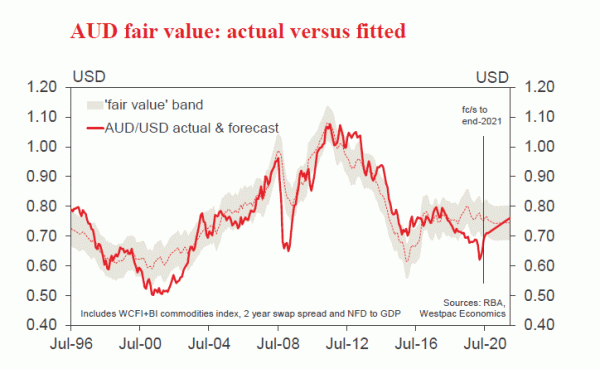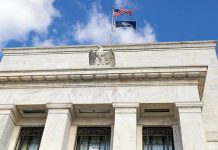As expected the Reserve Bank Board decided to maintain its policy settings including the targets for the cash rate and the three year bond rate at 25 basis points at its August meeting. The policy outlook is unchanged, highlighted by consistent support for expansionary fiscal policy with the accommodative monetary policy stance being “ maintained as long as it is required”.
The Governor revealed that $29 billion of the available Term Funding Facility has been drawn down. Last month the Governor pointed out that due to banks’ increasing their loans to small business ($5 million per million lent) and large business ($1 million per million lent) the facility had increased from $90 billion to $150 billion. With the facility needing to be drawn down by end September there is likely to be a considerable boost to system liquidity in the December quarter.
The Governor noted that the economy is expected to contract by 6% in 2020. Given the recent developments in Victoria not revising down its growth forecast from the May Statement on Monetary Policy indicates that the Bank has been positively surprised by the growth progress in the other states.
It has lowered its forecast for growth in 2021 from 6% to 5%, sensibly recognising that activity in the economy by end 2021 will be lower than at the beginning of 2020. These forecasts have been confirmed by today’s Statement on Monetary Policy.
Westpac has been consistently more constructive on the growth outlook for 2020 and now expects a contraction of 4.7% in 2020, taking into account a contraction of 9% in Victoria in the September quarter.
Recall that the forecasts in May were based on AUD at USD 0.64 over the forecast period. Despite the AUD now being set at USD 0.72 for the purposes of the forecasts the Governor has not materially changed his growth forecasts.
He still made no comments on the level of the AUD in his recent Statement and in the Statement on Monetary Policy noted that the AUD is “broadly consistent with its fundamental determinants”.
It seems that the Bank’s “pain threshold “ for the AUD is some way off.
That threshold is significantly affected by “fundamentals”. Our own fair value model for AUD currently stands at around USD 0.77 allowing ample scope for further appreciation without unnerving the RBA.
Indeed, since we raised our forecasts for AUD to USD 0.76 by end 2021 the AUD has lifted from USD0.68 to USD 0.72. That current pace of recovery in the AUD is somewhat faster than we envisaged in early June with our “target” level of USD 0.72 expected to take until December to be reached
For now, we are comfortable not to change that December target but clearly recognise the upside risk.
The current period of AUD appreciation is likely to be measured in years rather than months. If we look back at the cycles of the AUD since mid-1990’s that there was one upswing (late 2001 to July 2008 (GFC)) that lasted around seven years. Of course ,that period coincided with the first “industrialisation” burst in China. There was another five year period marking the “pre China” fall in the AUD.
Since the GFC we have seen a three year upswing (linked to China’s post GFC fiscal stimulus); followed by a four year downswing ;a two year upswing; followed by a two year downswing.
The only sustained “short” cycle was the nine month collapse in the AUD immediately following the GFC.
The point is that once a clear trend has been established, the AUD has a solid history of sustaining the trend for a number of years.
With AUD now four months into what appears likely to be an established up swing history is clearly encouraging us to expect that upswing to be sustained through, at least, 2021 if not considerably further.
That outlook is certainly in line with our forecast that AUD will lift consistently through 2021 from USD 0.72 to USD 0.76. With fair value currently estimated at USD 0.77 and spot at around USD 0.72 there is a US 5¢ undervaluation of AUD – fundamentals are consistent with a higher AUD. However we do see that gap with fair value closing significantly in 2021.
Firstly, the supply/demand imbalance for iron ore that has boosted prices in 2020 is likely to ease through 2021. Secondly, the risk premium associated with current global uncertainty which is partly driving that wedge with fair value, is likely to reduce significantly as global growth recovers in 2021.
Indeed our commodity price forecasts are consistent with a fall in fair value next year from USD0.77 to USD0.75. However, with the risk environment easing significantly through 2021 it seems likely that “spot” can hold above fair value, consistent with our current USD0.76 forecast.
We have certainly seen fair value sustainably above spot in some of those earlier cycles. As discussed our USD0.76 forecast for AUD by end 2021 has upside risks. If AUD was to move markedly above fair value the Reserve Bank would be less comfortable that AUD is in line with fundamentals.
That discomfort is likely to be exacerbated by an unemployment rate around 7.5% and inflation near to 1%.
Under those circumstances, the current policy approach, which is to characterise policies to address the currency as “extraordinarily unlikely” might have to be reconsidered.
That style of policy includes negative interest rates and currency intervention.













